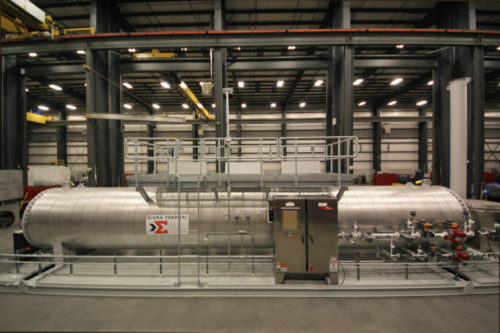The Advantages of Using Molten Salts for Process Heating
The Advantages of Using Molten Salts for Process Heating
Molten salts, also known as salt melts, comprise a variety of products that are used across many applications. Some applications that rely on molten salts include steel heat treating and annealing, high-temperature process heating, and thermal storage for solar thermal power plants. Depending on the needs of a specific application, different salts are available to use such as chlorides, bromides, fluorides, organic salts, and nitrates. Many applications use a eutectic blend of potassium nitrate and sodium nitrate.While there are several heat transfer fluid options available, molten salts are more ideal for certain applications due to the specific features unique to them.

Why Molten Salts?
There are several advantages of molten salts that make them appealing for use in a wide range of applications. The molten salts that are used most frequently in heat transfer applications are nitrate salts due to their low salt melting point, thermophysical properties, low vapor pressure, high operating temperature, corrosion performance, and low toxicity.
Molten salts help increase the maximum temperature limits in which a liquid heat transfer media can be utilized. Although individual salts are usable in these applications, combining two salts together helps reduce the melting point. The reduced melting point enables lower minimum operating temperatures, which minimizes the risk of freezing.
Waste heat recovery boiler
For example, the melting point of sodium nitrate is 584 °F or 307 °C, and the melting point of potassium nitrate is 631 °F or 333 °C. Combined, the two salts have a melting point of 431 °F or 222 °C. This melting point significantly expands the salt’s operational flexibility for use in various high-temperature applications.
If an application operates at temperatures exceeding 734 °F or 390 °C and requires a type of liquid heat transfer media, it will need to use a molten salt fluid.
Benefits for Industrial Applications?
A wide range of salt blends can help achieve specific operating temperatures required in certain applications. Compared to hydrocarbon fluids, molten salts experience minimal vapor pressure, regardless of how close operating temperatures are to their limits. As a result, high-pressure equipment and piping are almost entirely unneeded.
Molten salts are also usable at higher temperatures compared to other fluids such as silicone fluids and synthetic oils. They also have thermal stability and good heat transfer properties. Their high efficiency makes them suitable for use as heat transfer and molten salt energy storage media, as they are eco-friendly and can reduce operating costs.
Request Your Custom Molten Salt Systems
Depending on your application’s requirements, there are three main types of molten salt heating systems you can use. These include circulated molten salt, salt bath heaters, and direct heating for applications such as metal assembly heat treating.
-
Top Industrial Boiler Contractors Supplier & Factory Quality Products & ServicesNewsJun.10,2025
-
Panasonic Hot Water Boiler - Reliable & Energy Efficient Heating SolutionNewsJun.10,2025
-
Pennco Steam Boilers High-Efficiency & Durable SolutionsNewsJun.10,2025
-
Industrial Boiler & Mechanical Solutions Efficient Industrial Heating SystemsNewsJun.10,2025
-
Panasonic Hot Water Boiler - Energy-Efficient, Reliable Heat SolutionNewsJun.10,2025
-
Premium Power Plant Steam Boilers High Efficiency & ReliabilityNewsJun.09,2025


